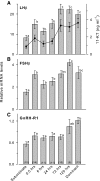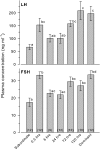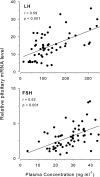Plasticity of the reproductive axis caused by social status change in an african cichlid fish: I. Pituitary gonadotropins
- PMID: 21068157
- PMCID: PMC3219043
- DOI: 10.1210/en.2010-0875
Plasticity of the reproductive axis caused by social status change in an african cichlid fish: I. Pituitary gonadotropins
Abstract
Social position in a dominance hierarchy is often tightly coupled with fertility. Consequently, an animal that can recognize and rapidly take advantage of an opportunity to rise in rank will have a reproductive advantage. Reproduction in all vertebrates is controlled by the brain-pituitary-gonad axis, and in males of the African cichlid fish Astatotilapia burtoni, GnRH1 neurons at the apex of this axis are under social control. However, little is known about how quickly social information is transformed into functional reproductive change, or about how socially controlled changes in GnRH1 neurons influence downstream actions of the brain-pituitary-gonad axis. We created an opportunity for reproductively suppressed males to ascend in status and then measured how quickly the perception of this opportunity caused changes in mRNA and protein levels of the pituitary gonadotropins. mRNA levels of the β-subunits of LH and FSH rose rapidly in the pituitary 30 min after suppressed males perceived an opportunity to ascend. In contrast, mRNA levels of GnRH receptor-1 remained unchanged during social transition but were higher in stable dominant compared with subordinate males. In the circulation, levels of both LH and FSH were also quickly elevated. There was a positive correlation between mRNA in the pituitary and circulating protein levels for LH and FSH, and both gonadotropins were positively correlated with plasma 11-ketotestosterone. Our results show that the pituitary is stimulated extremely rapidly after perception of social opportunity, probably to allow suppressed males to quickly achieve reproductive success in a dynamic social environment.
Figures





Similar articles
-
Social Transitions Cause Rapid Behavioral and Neuroendocrine Changes.Integr Comp Biol. 2015 Aug;55(2):294-306. doi: 10.1093/icb/icv057. Epub 2015 Jun 1. Integr Comp Biol. 2015. PMID: 26037297 Free PMC article. Review.
-
Plasticity of the reproductive axis caused by social status change in an african cichlid fish: II. testicular gene expression and spermatogenesis.Endocrinology. 2011 Jan;152(1):291-302. doi: 10.1210/en.2010-0876. Epub 2010 Nov 17. Endocrinology. 2011. PMID: 21084443 Free PMC article.
-
Mechanistic target of rapamycin (mTOR) implicated in plasticity of the reproductive axis during social status transitions.Gen Comp Endocrinol. 2019 Oct 1;282:113209. doi: 10.1016/j.ygcen.2019.113209. Epub 2019 Jun 18. Gen Comp Endocrinol. 2019. PMID: 31226256 Free PMC article.
-
Physiological consequences of social descent: studies in Astatotilapia burtoni.J Endocrinol. 2006 Jul;190(1):183-90. doi: 10.1677/joe.1.06755. J Endocrinol. 2006. PMID: 16837622
-
Social regulation of male reproductive plasticity in an African cichlid fish.Integr Comp Biol. 2013 Dec;53(6):938-50. doi: 10.1093/icb/ict017. Epub 2013 Apr 23. Integr Comp Biol. 2013. PMID: 23613320 Free PMC article. Review.
Cited by
-
Social Transitions Cause Rapid Behavioral and Neuroendocrine Changes.Integr Comp Biol. 2015 Aug;55(2):294-306. doi: 10.1093/icb/icv057. Epub 2015 Jun 1. Integr Comp Biol. 2015. PMID: 26037297 Free PMC article. Review.
-
The involvement of gonadotropins and gonadal steroids in the ovulatory dysfunction of the potamodromous Salminus hilarii (Teleostei: Characidae) in captivity.Fish Physiol Biochem. 2015 Dec;41(6):1435-47. doi: 10.1007/s10695-015-0097-y. Epub 2015 Jul 17. Fish Physiol Biochem. 2015. PMID: 26183262
-
Hormonal regulation of social ascent and temporal patterns of behavior in an African cichlid.Horm Behav. 2019 Jan;107:83-95. doi: 10.1016/j.yhbeh.2018.12.010. Epub 2019 Jan 4. Horm Behav. 2019. PMID: 30578818 Free PMC article.
-
Gonadotropin-releasing hormone plasticity: a comparative perspective.Front Neuroendocrinol. 2012 Aug;33(3):287-300. doi: 10.1016/j.yfrne.2012.09.001. Epub 2012 Oct 3. Front Neuroendocrinol. 2012. PMID: 23041619 Free PMC article. Review.
-
Social information changes the brain.Proc Natl Acad Sci U S A. 2012 Oct 16;109 Suppl 2(Suppl 2):17194-9. doi: 10.1073/pnas.1202552109. Epub 2012 Oct 8. Proc Natl Acad Sci U S A. 2012. PMID: 23045669 Free PMC article. Review.
References
-
- Bennett NC 1994 Reproductive suppression in social Cryptomys damarensis colonies: a lifetime of socially induced sterility in males and females (Rodentia: Bathyergidae). J Zool (London) 234:25–39
-
- Koyama S, Kamimura S 2000 Influence of social dominance and female odor on the sperm activity of male mice. Physiol Behav 71:415–422 - PubMed
-
- Altmann J, Sapolsky R, Licht P 1995 Baboon fertility and social status. Nature 377:688–690 - PubMed
-
- Kobayashi Y, Nakamura M, Sunobe T, Usami T, Kobayashi T, Manabe H, Paul-Prasanth B, Suzuki N, Nagahama Y 2009 Sex change in the Gobiid fish is mediated through rapid switching of gonadotropin receptors from ovarian to testicular portion or vice versa. Endocrinology 150:1503–1511 - PubMed
-
- Ohta K, Mine T, Yamaguchi A, Matsuyama M 2008 Sexually dimorphic expression of pituitary glycoprotein hormones in a sex-changing fish (Pseudolabrus sieboldi). J Exp Zool Part A Ecol Genet Physiol 309:534–541 - PubMed
Publication types
MeSH terms
Substances
Grants and funding
LinkOut - more resources
Full Text Sources
Miscellaneous

